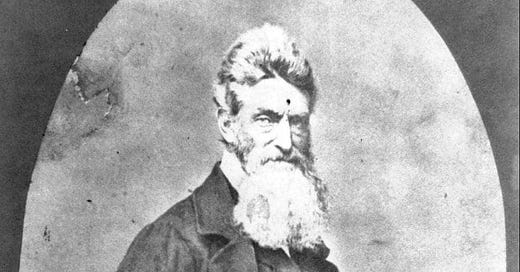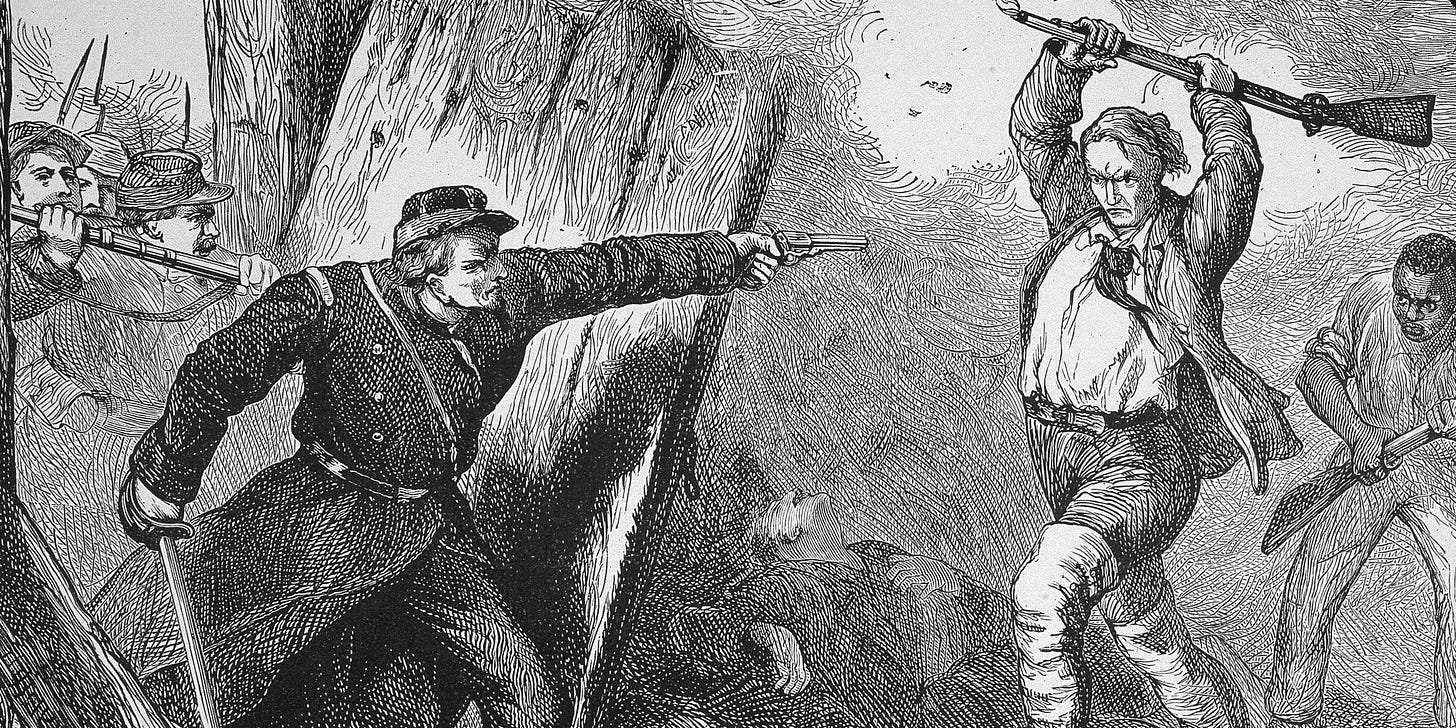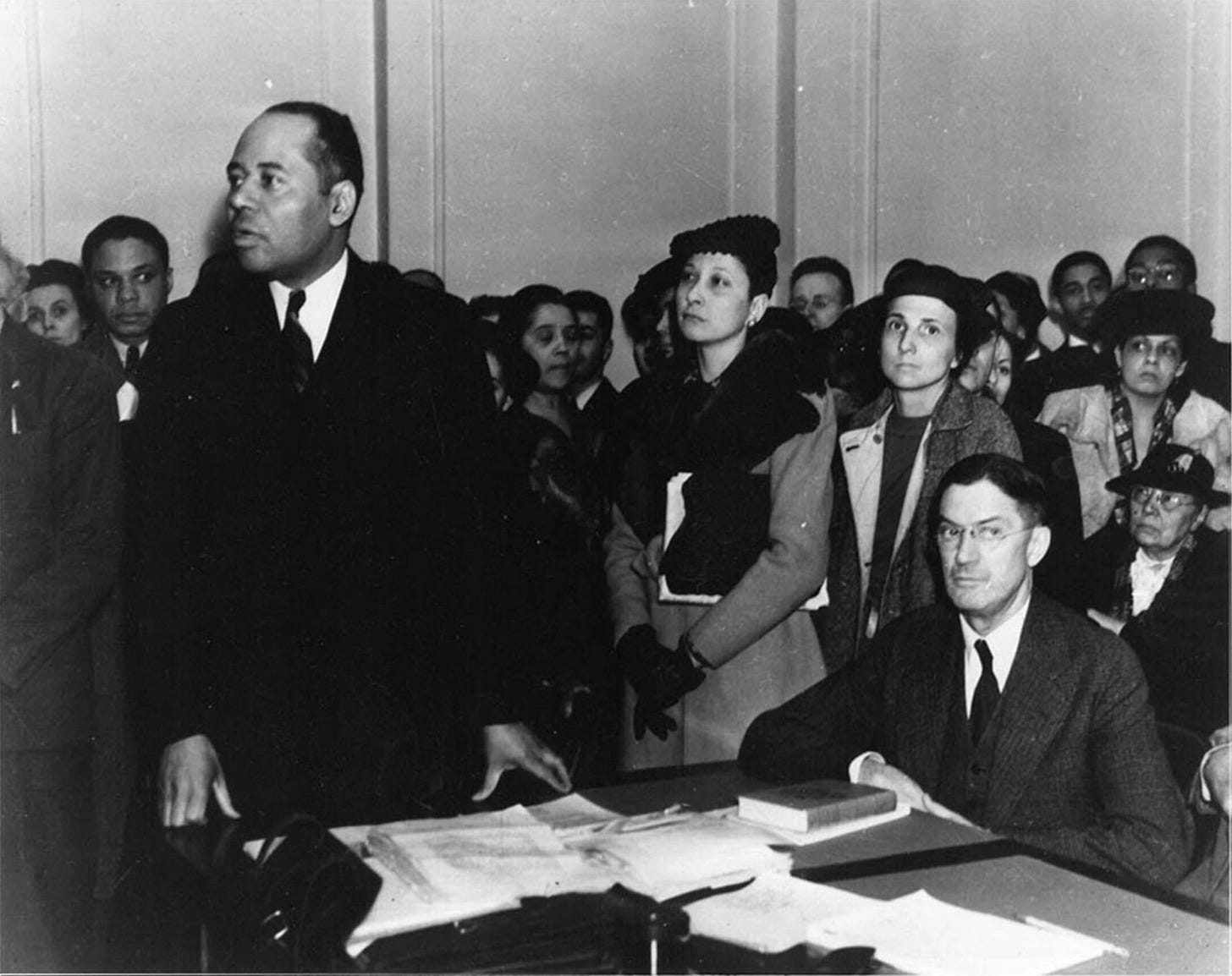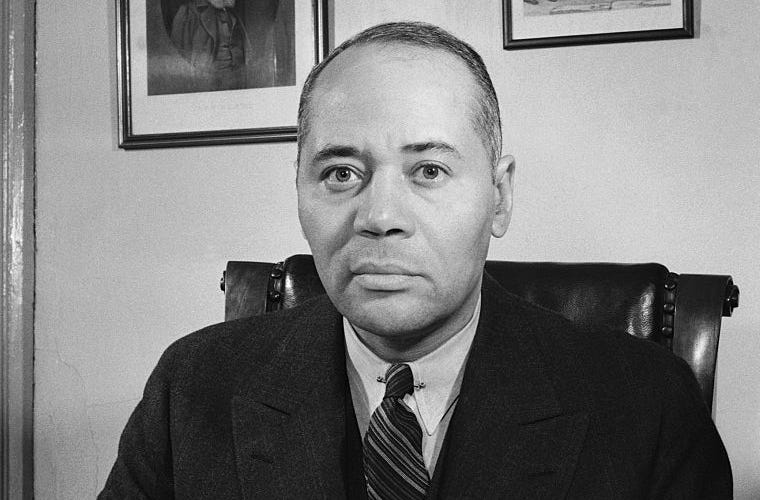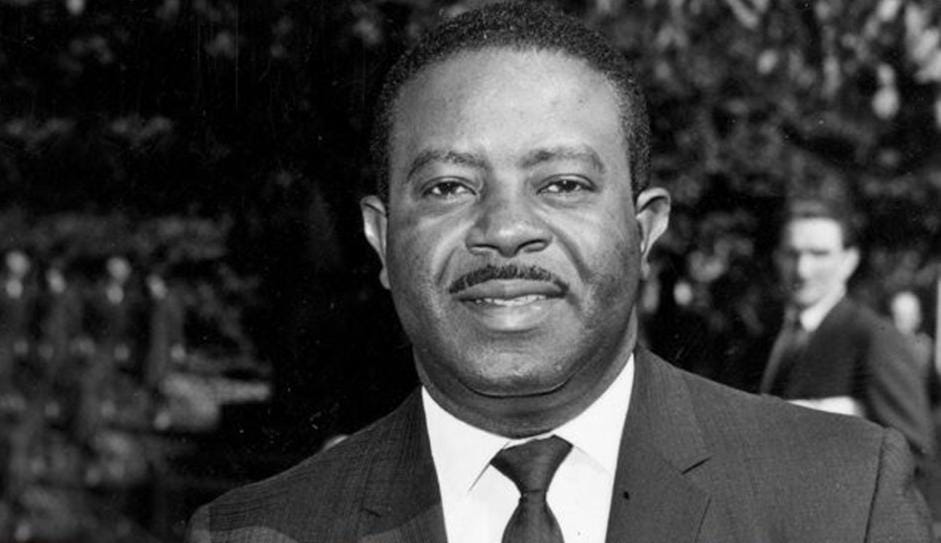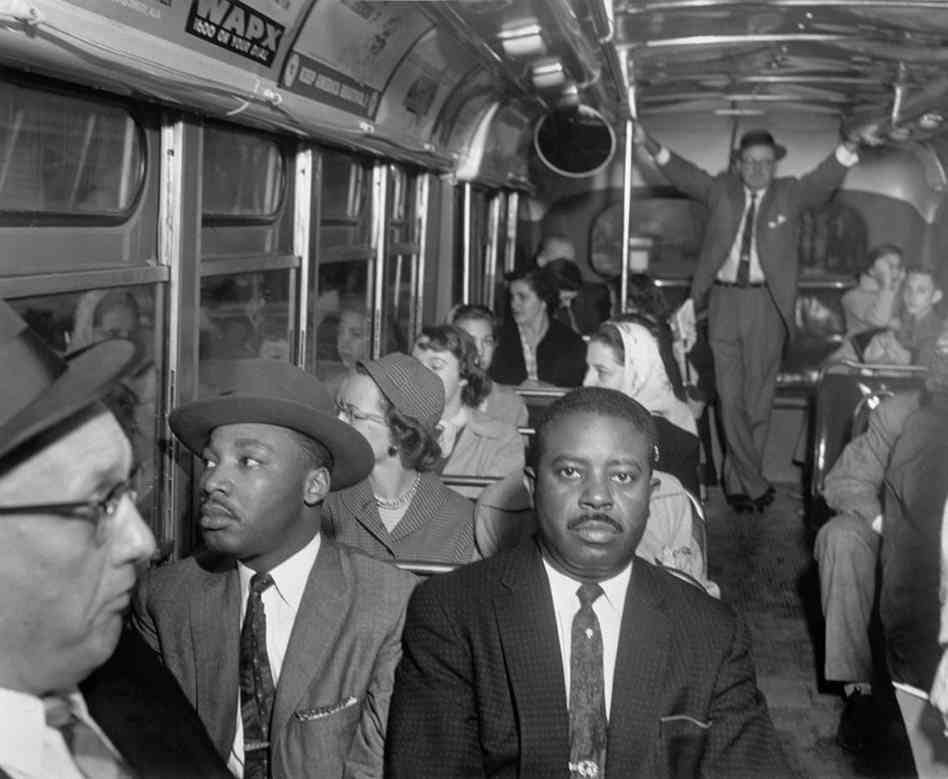One Mic Black History Newsletter #7
Today we tell the stories of the life of John Brown, Charles Houston and Ralph David Abernathy
Good Day, Fam, Welcome Back to One Mic History Newsletter. Thank you for joining us today. I appreciate you. If you enjoy stories like this you can find more stories like this on One Mic History.
The Legend of John Brown
John Brown was an American abolitionist who advocated for the emancipation of slaves in the United States during the mid-19th century. He is most well known for his involvement in a failed rebellion in 1859, known as the Harpers Ferry Raid.
John Brown was born on May 9, 1800, in Torrington, Connecticut, to Owen and Ruth Mills Brown. When John was still a young child, his father relocated the family to Hudson, Ohio, which was a key stop on the Underground Railroad. Owen Brown became active in the effort to help former enslaved people find freedom and the Brown family home became a safe house.
At 16, John left his family and traveled to Massachusetts and then Connecticut, where he attended school and was ordained a minister. Brown was a deeply religious man and believed that slavery was a sin. He was involved in several antislavery efforts, He traveled around the United States to raise money and acquire arms to support his cause, while also forming a secret network that aided fugitive slaves in their journey to freedom.
Brown's sons were involved in the abolitionist movement and called upon their father for help in the face of an attack from pro-slavery settlers. This led to the Pottawatomie Massacre in 1856, which resulted in the deaths of five pro-slavery settlers. These events, along with many others, became known as Bleeding Kansas. Brown's legend as a militant abolitionist was just beginning, and he was determined to make a statement against slavery.
By early 1859, Brown was leading raids to free enslaved people in areas where forced labor was still in practice, primarily in the present-day Midwest. At this time, he also met Harriet Tubman and Frederick Douglass, activists and abolitionists both, and they became important people in Brown’s life, reinforcing much of his ideology.
With Tubman, whom he called “General Tubman,” Brown began planning an armed insurrection against the slaveholders, as well as a United States government at Harpers Ferry, Virginia (now West Virginia) in oct 1859 . His goal was to spark a wider slave rebellion that would eventually bring down the institution of slavery. He recruited 22 people, including his sons and several freed enslaved people, and received military training from experts in the abolitionist movement.
On October 16, the group captured Colonel Lewis Washington, a distant relative of George Washington who owned enslaved people, and they began a raid on Harpers Ferry to seize weapons and pro-slavery leaders in the town. However, a baggage handler was shot and killed in the process. Brown and his men were able to capture several local slaveowners, but the local townspeople quickly formed a militia and surrounded the armory.
Brown and his men were forced to move to the armory’s engine house, which later became known as John Brown’s Fort. The militia attacked and freed several captives, but eight railroad men died in the process. Late in the afternoon of October 17, President James Buchanan ordered a company of Marines under the command of Robert E. Lee to march into Harpers Ferry. The Marines stormed John Brown's Fort, taking all of the abolitionist fighters and their captives alive.
Ultimately, Brown's raid failed and he was arrested and found guilty of treason against the Commonwealth of Virginia. On December 2, 1859, Brown was hanged at the age of 59 in Charles Town, with actor and pro-slavery activist John Wilkes Booth among the witnesses. After his execution, his wife, Mary Ann (Day), brought his body back to the family farm in upstate New York, which is now the John Brown Farm State Historic Site, a National Historic Landmark.
The Harpers Ferry Raid had a major impact on American politics, Although Brown’s actions didn’t bring an end to slavery as it pushed the nation closer to the Civil War. Brown’s actions and his subsequent execution helped to galvanize anti-slavery forces in the North, while also enraging pro-slavery forces in the South. His death was seen as a hero and martyr to the anti-slavery cause. today legacy lives on today as a symbol of courage and defiance in the face of injustice.
Charles Hamilton Houston
Charles Hamilton Houston, a lawyer and civil rights advocate, is known as the architect of the legal strategy that led to the 1954 U.S. Supreme Court ruling, Brown v. Board of Education. He was born on September 3, 1895 in Washington, DC, to William Houston, an attorney, and Mary Houston, a hairdresser and seamstress. He attended M Street High School (later Dunbar High School) and went on to Amherst College, where he was the only black student in his class.
Upon graduating in 1915, Houston joined the U.S. Army and was deployed to France. His experiences with racial discrimination while in the military deepened his resolve to study law. After his military discharge in 1919, Houston enrolled at Harvard Law School, becoming the first black editor of the Harvard Law Review.
Houston was later hired by the National Association for the Advancement of Colored People (NAACP) as Special Counsel and mentored Thurgood Marshall, a student of his at Howard University Law School. The two developed a legal strategy to challenge school segregation, first by calling for the equalization of facilities for black students and then for full integration. He was also the architect of the civil rights strategy that led to the U.S. Supreme Court’s 1954 decision in Brown v. Board of Education
In 1935, Houston and Marshall took on the Pearson v. Murray case, which called for the admission of Donald Gaines Murray to the University of Maryland School of Law, Houston and Marshall successfully argued that the state had violated Murray’s rights by failing to provide an adequate law school for his studies while denying him admission to the sole state law school on the grounds of race.
Houston contributed to the civil rights movement for the next fifteen years before his death in 1950. His efforts, alongside those of Thurgood Marshall, paid off when the Supreme Court handed down the Brown decision four years later in 1954.
Ralph David Abernathy
Ralph David Abernathy was an African American civil rights leader who worked alongside Martin Luther King, Jr. to promote justice and equality for African Americans in the United States. His contributions to the civil rights movement were essential in the fight for racial equality and civil rights.
Abernathy was born in Linden, Alabama in 1926. His parents, Louivery and William Abernathy, were both sharecroppers. He attended college at Alabama State University where he was heavily involved in student activities and civil rights work. He graduated with a bachelor’s degree in mathematics. After college, he attended the Crozer Theological Seminary in Pennsylvania where he earned a master’s degree in theology.
In the 1950s, Reverend Ralph David Abernathy and Martin Luther King Jr. became close friends and colleagues. Abernathy was the pastor of Montgomery's First Baptist Church and Dr King was the pastor at Dexter Avenue Baptist Church. During this period he was active in the National Association for the Advancement of Colored People. He urged other ministers to stand against segregation and stating it's “Our business as Christians is to get rid of a system that creates bad men”
Shortly after the arrest of Rosa Parks on 1 December 1955, Local NAACP president E. D. Nixon contacted Abernathy to discuss the idea of a bus boycott. Abernathy, King, and other key figures in the civil rights movement then convened to form a new organization to guide the Montgomery Bus Boycott. This event eventually resulted in the establishment of the Southern Christian Leadership Conference (SCLC) which Abernathy and King co-founded along with other civil rights activists in 1957.
Reverend Ralph Abernathy was a prominent figure in the civil rights movement who helped organize numerous protests and demonstrations. He was arrested 17 times for his involvement in the movement and was often seen as Dr. Martin Luther King Jr.’s right-hand man. Abernathy and King’s distinct styles complemented each other, creating a powerful and inspiring message during weekly mass meetings. King would discuss the philosophical implications of nonviolence and the civil rights movement, while Abernathy encouraged positive action. Following King’s speeches, Abernathy would declare, “Now, let me tell you what that means for tomorrow morning.” He was an influential speaker and orator who delivered powerful speeches that inspired people to take action.
After the assassination of Dr. Martin Luther King Jr. in 1968, the Reverend Ralph Abernathy assumed a greater role in the civil rights movement and became a prominent leader in his own right. He was instrumental in the organization of the Poor People's Campaign, which was a march on Washington D.C. to call for economic justice for those in poverty. Additionally, he held the position of president of the Southern Christian Leadership Conference from 1968 until 1977. He dedicated the remainder of his life to the fight for civil rights, until his passing in 1990.
Abernathy’s legacy is one of courage and perseverance in the face of adversity. He was a tireless advocate for civil rights and racial justice and was willing to risk his life for his beliefs. His commitment to the cause inspired many people and helped to bring about positive change in the United States. His legacy of activism and civil rights work continues to be celebrated and remembered today.
Thank you so much for joining us today, I hope you have a wonderful day, If you like stories like this you can find more stories like this at One Mic History.
Thank you and I appreciate your support.
-Countryboi

